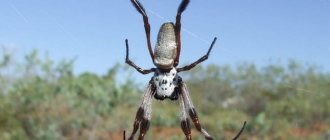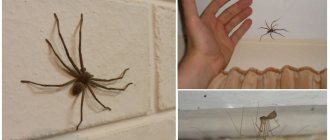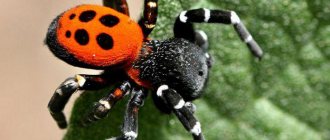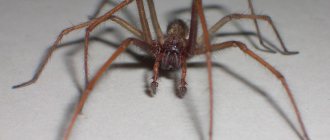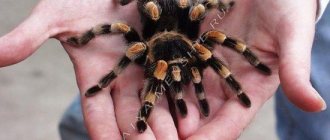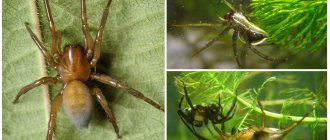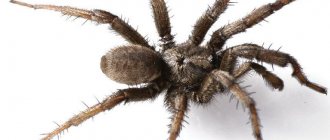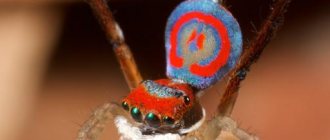Nature has endowed each dangerous spider with quite powerful poisonous fangs that paralyze the victim. The spider's venom is so strong that it can literally turn the victim's body tissue into slurry. There are about forty-two thousand species of spiders on Earth, but only a few pose a threat to human life. Due to its size, it is difficult for a spider to bite through human skin, but if it succeeds, it is unlikely to cause serious harm to health. However, there are a number of spiders that can kill a person. It is these species that we will talk about today. We recommend that you get acquainted with ten far from harmless, but even the most dangerous spiders in the world.
Karakurt - the most dangerous spider in the world
Karakurt, or as it is also called, the black widow, cannot boast of its impressive size, but it is capable of producing such a powerful poison, in which the content of neurotoxins is many times higher than that of a cobra. After being bitten by a dangerous karakurt spider, a person feels a sharp pain that spreads throughout the body within half an hour. The next five days of the bitten person pass as if in a fog, with weakness, dizziness and vomiting. If the victim is not given appropriate assistance, he will die. Only female karakurts pose a danger to the life of Homo sapiens, since males very often become victims themselves. The habitats of the most dangerous spider are the steppes of Ukraine, Russia, Kyrgyzstan and Kazakhstan.
Spider Biology
Before we begin to describe the types of the most terrible and beautiful spiders in the world, let us remind you what they are as animals, what their biology is. The order of spiders includes more than forty thousand species, of which almost three thousand can be found in the territory of the former Soviet Union. However, all these species are similar both in appearance and in body structure. They have a lot in common in their lifestyle, nutrition and reproduction.
Appearance and body structure
The bodies of all spiders consist of two parts: the cephalothorax and abdomen, which are connected by a thin tube, also called a “stalk.” On the cephalothorax in front there are small processes: chelicerae and pedipalps, and on the sides there are four pairs of walking limbs - the legs themselves.
Chelicerae are jaw appendages on the sides of the spider's mouth that help capture prey. The pedipalps perform the functions of taste and olfactory receptors; in sexually mature males they are also conductors of seminal fluid.
In the belly of spiders there is a heart, gonads, and a spinning apparatus that produces secretion for knitting webs.
Nutrition
All spiders are predators, with the exception of the haymaker spider, which feeds on plant leaves. Most spiders use webs to hunt insects and other animals, but some species hunt in ambush mode; this applies to the largest representatives of the spider kingdom.
The spider feeding process itself looks like this:
- The spider injects poison into the body of a victim captured in one of these ways.
- When the victim dies, digestive fluid is injected into its body.
- After some time, the insides of the killed animal are digested, and the spider sucks out the resulting food.
This process is called external digestion.
Growth and shedding
The body of a spider is not capable of stretching, therefore, throughout its life, a growing spider increases its body due to molting, after which the exoskeleton of the insect increases. New chitinous cover appears in spiders 5-10 times during the life cycle, depending on the species.
Reproduction
Male spiders are much smaller in size than their female companions and in many species, after mating, they are often eaten by female companions. They, in turn, weave cocoons from the web, where they lay eggs. Often the female wears such a cocoon on herself for a long time until the babies gain enough strength to develop independently.
Sydney funnel web spider - one of the 10 most dangerous spiders
The Sydney funnel web spider is very aggressive and always attacks humans first. Its bite causes paralysis of the human nervous and respiratory system. Males are more poisonous than females and more confident, and therefore fearlessly penetrate human dwellings. The victim needs to be administered an antidote as soon as possible; it’s good that this type of dangerous spider lives in Sydney, where an antidote was invented long ago.
Tarantulas can shoot poisonous needles
Tarantulas are large spiders covered in hairs, which make them even more repulsive to humans. There are many legends about deadly tarantula bites, but they are not true: tarantulas are not very aggressive creatures and will not bite unless they are attacked, and their bite, although painful, is no more unpleasant or dangerous than a wasp sting . But tarantulas have another, much more terrible weapon. If you show aggression towards it, it turns its belly towards the source of danger and shoots a bunch of poisonous hairs in its direction - thin as threads and sharp as needles. Digging into the victim's skin, these hairs cause severe irritation. The only way to quickly get rid of them is to use duct tape as an emergency hair removal strip.
The Australian widow is one of the most dangerous poisonous spiders
Every resident of Australia knows this dangerous spider. The Australian widow spider differs in appearance from other spiders. It has a red longitudinal mark on its round belly. The spider lives in urban environments, and therefore its encounters with humans are not uncommon. During the bite, the Australian widow controls the dosage of the poison, but small children and elderly people die without the necessary medical care. After the bite of the Australian widow, swelling, colic, excessive sweating and unpleasant nausea persist for a long time.
The most terrible spiders
Each species of spider is scary in its own way, but this one can make you freeze in horror with its method of caring for its offspring. The fact is that the females of these creatures lay eggs and carry them on their backs for a long time, attaching them with a web. Not scary yet? Then see what the female looks like after hatching her babies.
Sometimes there are so many children that the spider’s body is completely covered with them - only the eyes remain visible. Dozens of tiny spiders ride on their mother's back until they learn to forage for food on their own. Imagine seeing such a spectacle at home - it was precisely for such occasions that Elon Musk probably started selling flamethrowers.
North American black widow
The terrible name of a spider does not make a dangerous representative of the order of arthropods a maniac killer. The black widow injects a poison that causes a terrible allergic reaction. Over the past hundred years, thirteen people have died from black widow bites, although before the development of a vaccine, more than five percent of those bitten died. North America, New Zealand and Australia - these are the regions where dangerous representatives of the order arthropods live.
Brown recluse spider
The brown recluse spider is also called the fiddle spider. It is found in the south in the USA and northern Mexico. Residents of these regions try to avoid contact with the recluse spider, as its venom is toxic enough to kill a person. After exposure to toxic substances contained in the venom of a recluse spider, tissue rejection begins at the site of the bite, which without medical assistance can lead to tragic fatal consequences.
South Russian tarantula - the largest spider in Russia
Mizgir, or South Russian tarantula, is a characteristic representative of the wolf spider family. The body size of the female of this spider reaches three centimeters (the male's body is slightly shorter). The span of its legs, however, is considerable - 10-11 centimeters. It is widespread not only in Russia, but also in Central Asia.
Mizgir is characterized by shallow burrows in the sand or in the ground, which this spider digs itself and lines the inside with cobwebs. He spends daylight hours in them, but at night he can go out to hunt on the surface. Excellently sensing vibrations, the mizgir senses when a small insect approaches its shelter. Having brought its prey close, the spider instantly rushes at it and kills it. In winter, he deepens the hole and fills the entrance with earth.
This tarantula practically does not bite people. If a bite occurs, the pain and consequences are comparable to a hornet sting.
Brazilian wandering spider
The jumping and lightning-fast wandering spider very easily penetrates into a home, car, bag, and clothing pockets. A contact encounter with a Brazilian spider usually ends in paralysis of the muscular system and suffocation. Although poison rarely causes death, it is still unpleasant to feel the effects of toxins with a lack of air. Men should generally avoid contact with the wandering spider, as there is a high risk of becoming impotent after being bitten.
The six-eyed sand spider is a dangerous representative of the order of arthropods
The six-eyed sand spider earned its name due to the fact that it is quite skillful at burrowing into the sand and hunting prey. Nature did not reward the six-eyed sand spider with the ability to weave a web. This feature distinguishes this representative from other classes of spiders. The bite of this dangerous spider causes hemorrhage, but science knows of only two cases of death. Scientists conducted more than one experiment on rabbits, as a result of which all experimental subjects died after being bitten by a six-eyed spider.
The most interesting types of spiders
Now we have come to the most interesting part; in this chapter we will present the most terrible spiders with a description of the species. However, many spiders are unusually beautiful and interesting to study and simple contemplation.
Tarantula Goliath
Living in the tropical forests of the South American continent, goliaths are able to feed on small hummingbirds, for which they received the name tarantulas.
Goliath belongs to the tarantula spiders, in Latin it is called Theraphosa Blonde. This is the largest known spider. The length of its body reaches nine centimeters in females, and its leg span is twenty-five.
Living in the tropical forests of the South American continent, goliaths are able to feed on small hummingbirds, for which they received the name tarantulas.
Peacock spider
It's hard to believe that this undeniable beauty is only five millimeters in size. It must be said that not a single lady from the spider kingdom can resist such a gentleman, because in addition to his elegant appearance, he demonstrates a truly charming dance to his chosen one. You can see it at the end of the article.
Six-eyed sand spider
This is one of the most dangerous spiders in the world. Its venom is often equated to the venom of a black widow in terms of concentration. Sand spiders live in southern Africa, but some representatives of this genus have been spotted by biologists in South America.
A distinctive feature of this species is its crab-like body size and hunting method.
Sand spiders hunt by camouflaging themselves in the sand, with which they blend in due to the light brown color of their body. Their victims are not only insects, but also quite large scorpions, although the body size of the spider is not at all outstanding. Females rarely exceed a length of one and a half centimeters.
Agitprop Spider
The beautiful spider also has the following names: “striped hunter”, “wasp spider”. This representative of the spider family even lives in central Russia. With his appearance, he warns that he has a certain supply of poison and it is unsafe to contact him.
Dolomedes
A notable feature of this spider is its life on the shore of a reservoir and its ability to hunt while gliding along the surface of the water. Some biologists claim that dolodemes are capable of staying under water for up to forty-five minutes.
The size of the fringe hunter (its second name) reaches two centimeters, but it is capable of feeding not only on insects, but also on tadpoles and even small fish.
Wall tegenaria
A rather rare representative of arachnids is considered one of the largest spiders in European countries. Its dimensions reach fifteen centimeters in the leg span. Tegenaria lives in rocky caves and can also take a liking to old stone buildings and structures.
This spider does not know how to weave a cocoon around its prey, but it does not need to. The fact is that wall tegenaria knits such a loose web that victims literally drown when falling into it.
Tarantula
Now let's talk about spiders, which are on everyone's lips not only because of their terrible beauty, but also because of their unusually sonorous names. We are, of course, talking about the tarantula and karakurt. Let's start with the less poisonous and dangerous.
Many have heard the story of how the Tarantella dance was born, which you supposedly had to dance to neutralize the poison after being bitten by this spider. Alas, it turned out to be just a beautiful legend.
However, the size of the tarantula, its leg span up to thirty centimeters (!) and its appearance can terrify any person, even those who do not suffer from arachnophobia. What are his eight terribly beautiful eyes worth?
Tarantulas do not weave webs, but hunt at night for anyone who is, as they say, shorter in stature, crawling to the surface at night from their deep burrows.
Tarantula - the largest dangerous spider
The tarantula is the largest representative of the arachnid class in the world, which lives in the desert or arid steppe. For humans, tarantula venom is not fatal and only causes swelling. Legends about the poisonousness of the tarantula have been circulating for centuries. Entire epidemics have been linked to a single tarantula bite. Even a dance called “tarantella” arose thanks to the myth that frantic dancing saves you from a tarantula bite.
Today we introduced you to ten dangerous spiders that pose a threat to human life. Try to avoid contact with the above dangerous spiders, which nature has awarded with a real opportunity to “defeat a person” in the literal sense of this expression. Don't risk your life. Be vigilant and careful!
Safe spiders
This group of spiders includes those representatives that are either unable to bite through human skin, or their venom is too weak to harm. Spiders of this class include:
- Tarantula spiders.
- Cross spiders.
- Harvester spider.
- House spider.
- Jumping spiders.
Man is of no interest to spiders, since their purpose is completely different - to live in nature so that no one touches them.
Tarantula spiders
These animals represent a group of the largest spiders on the planet, among which the goliath spider is considered the champion. Its size is simply amazing - about 10 cm, and its paw span is about 28 cm. These spiders are also distinguished by the fact that their body is covered with thick fur of red-brown shades. This monster is not dangerous for humans, but its falling stubble can lead to various allergic reactions.
Cross spiders
They are considered relatively large representatives of their genus. They can be easily distinguished from other types of spiders by their characteristic pattern in the form of a cross located on the back of the animal. This is a typical representative of gardens, parks, forests and other green spaces. It uses a web as a tool to catch food. The spider itself may be in a shelter of old leaves.
Spider bites are not dangerous even for children, but they can let the child know not to touch it.
Harvester spider
This living creature on long legs constantly annoys humans by constantly weaving a web, which has to be constantly removed. It prefers to live in houses or apartments, but it can also be found in other outbuildings. Not dangerous for humans.
House spider
Represents the family of funnel-web spiders. The family got its name due to the weaving of funnel-shaped webs. It can often be found in a person’s home, as well as in other places. The female grows in length up to 7 - 12 mm, and the male is more modest in size - only 6 to 9 mm. The body of the animal is distinguished by a brown tint. It does not show aggression towards people, but if you disturb it and put your finger in a shelter, it will definitely bite. In this case, there will be no negative consequences from the bite.
Jumping spiders
They represent one of the most numerous families. Found almost everywhere except Greenland. They differ in that they can jump, but they go out hunting mainly during the day. Horses are also distinguished by the unique structure of their bodies, namely the presence of a unique hydraulic system. Thanks to such capabilities, which make it possible to regulate pressure in the circulatory system, spiders can make jumps that are incommensurate with their own parameters.
Peacock spider
A unique species of spider, representing the genus of horses. This small living creature is endemic to Australia and is therefore not found anywhere else on the planet. This unusual creature got its name due to the fact that it practically copies the behavior of the most beautiful bird. Moreover, the male also has brighter colors compared to the female. During mating periods, the male spreads his tail and also uses the lateral scutes located on the abdomen. Together with his hind legs, he lifts them up. If there is no female, then the males wrap their scutes around themselves.
Hobo spider
They do not weave hunting webs, but hunt various insects from ambush. By the nature of their hunting and the structure of their eyes, they can be compared with wolf spiders. The female still weaves a web, but for completely different purposes - when she forms a cocoon, she lays eggs in it. At the same time, she carries the cocoon on her back.
Hunter bordered
It represents the family of hunting spiders and can grow up to 2 cm in length. It is distinguished by a yellow-brown body color, although depending on the living conditions, the color may have darker tones. A characteristic feature is the presence of a white stripe on both sides of its body. It prefers to settle on the banks of various bodies of water located in the temperate zone of Eurasia. The species is quite unique because individuals can move through the water and even dive if necessary. It has another name - the fishing spider, as it can hunt for fish fry.
Best articles: Dog intelligence: smart or beautiful?
Spider green
In fact, such a species does not exist in nature. Various spiders belonging to one genus or another can have a similar coloration. For example, green color can be:
- Jumping spiders.
- Huntsman spiders.
- Lynx spiders.
To find out how dangerous a green spider is, you first have to decide on its type.
Crab spider
This type of spider also does not exist, but some of the species can move sideways, like crabs. For example:
- Neocribellatae species.
- Thomisidae species.
- Philodromidae species.

